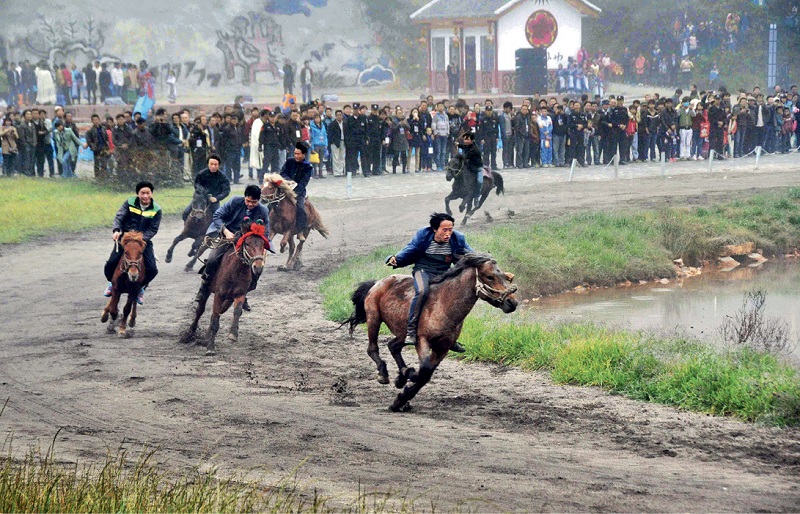
Yi ethnic people having a horse race to celebrate Yi’s New Year in the township of Bandi, Weining Yi, Hui and Miao Autonomous County, Bijie City, Guizhou Province.
The Yi’s New Year is a popular folk festival celebrated by the Yi ethnic group in Sichuan, Yunnan, and Guizhou provinces, and Guangxi Zhuang Autonomous Region on an auspicious day around November 20 every year. It has a long history, with early records dating back to the Tang Dynasty (618-917). There are many traditional customs and practices associated with this ethnic group’s New Year.
When the festival is soon to arrive, every household begins to conduct the task of house cleaning, dusting and cleaning all kinds of utensils in their homes. The intention of this activity is to get rid of all the bad things in the house, symbolizing Yi people’s good wish to ward off evil and bring in a good fortune. Yi people also pile firewood in high and neat stacks in front of their houses as they believe that the height of the stacks reflects the hard work they have done during the past year and also augurs a happy life they are going to have. On the eve of the Yi’s New Year, the whole family gathers together for a reunion dinner. People usually give the best part of the pork such as a pig’s hind leg or the head to the elderly as a token of respect.
On the day of the festival, young men and women from nearby villages gather together on a mountainside wearing their festive attire to participate in the traditional activities of the local New Year.
Moerqiu is a traditional seesaw-like swing activity which the Yi people enjoy. When playing the game, there is an equal number of people on both ends of a pole. Usually one to two men or women lie down on their stomachs or sit on the pole, and all kick the ground in the same direction to make it swing in the air. And when the players are in the air, they do tricks such as rolling and mounting the pole, which are the highlights of the game.
Wrestling is also a major event of the festival. Agility is the most essential skill in wrestling along with other techniques like pushing, pulling, grabbing, dodging, and lifting. The competitor who successfully takes down their opponent is the winner. Animals can also be the stars of the event, bull fighting, sheep fighting, and cock fighting activities are a collision of strength and power, featuring animals ramming each other with their heads and horns. Cheers and yells from the crowd add more tension to the animal competition. Pig racing is another classic event, during which pigs are tested to see which of them has the thickest pork fat, in other words, which pig is the fattest, and also which family has been the most hardworking during the previous year.
New Year’s activities would not be complete without visiting relatives and friends. The Yi people usually present such gifts as pork, drinks, pastries and other food when they go for a visit. The hosts and guests then sit together by the fire, drinking, eating meat, and catching up with each other about the latest news.
Today, the customs of Yi’s New Year are still well preserved in many Yi communities, and Yi’s New Year was listed as a national intangible cultural heritage in 2011. The good wish for peace and prosperity, respect for the elderly are fully reflected in the festive activities. These simple but vibrant customs of the Chinese Yi ethnic group which have been passed down from ancient times, exhibit their way of life and desire for a better future.